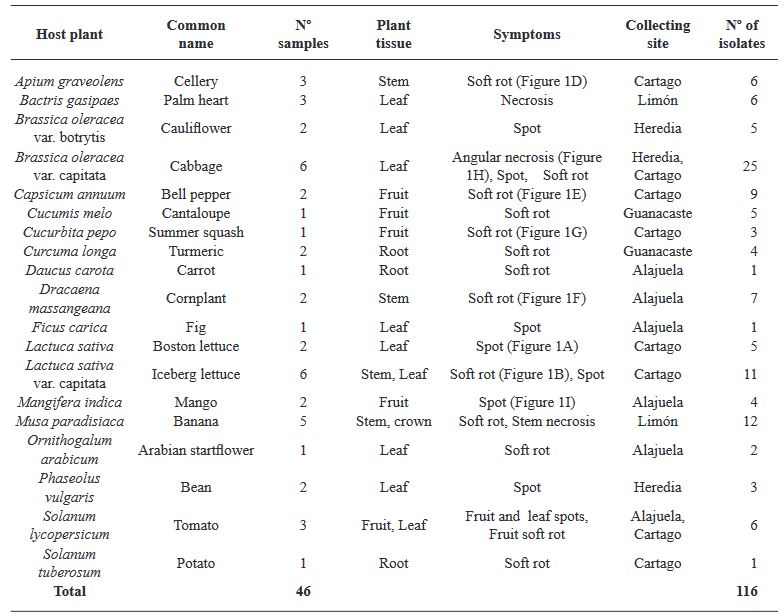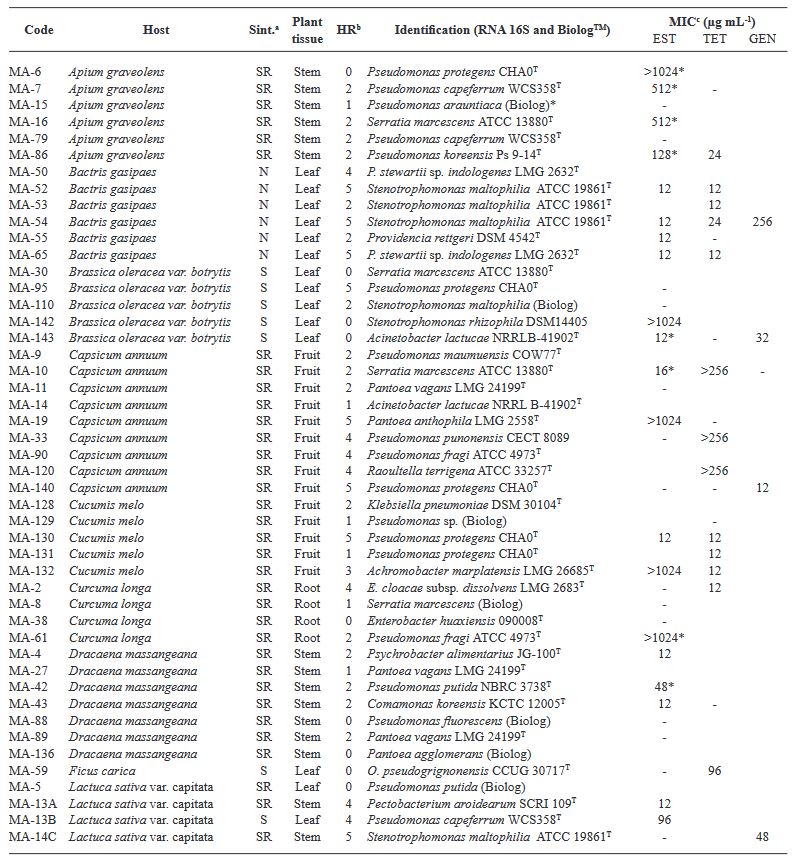Diversity and antibiotic resistance in bacteria associated with symptoms of bacterial infection in Costa Rican crops
By
Lorena Uribe Lorío*,
Lidieth Uribe ,
César Rodríguez ,
Luis Felipe Aráuz
* Corresponding Author. Email: / Institution: Universidad de Costa Rica
Accepted: 05/January/2023 – Published: 26/February/2024 – DOI: https://doi.org/10.18781/R.MEX.FIT.2305-5
Abstract Objetive/Background. The aim of this was to assess the diversity and antibiotic resistance of bacteria isolated from 19 crops with bacterial infection symptoms.
Materials and Methods. This collection was identified using 16S rRNA gene sequencing and the Biolog system. Susceptibility and minimum inhibitory concentration (MIC) for streptomycin, tetracycline, and gentamicin were determined using disk diffusion and E-test methods, respectively.
Results. A total of 55 species belonging to 20 bacterial genera were identified, with Pseudomonas, Serratia, Pantoea, and Stenotrophomonas being the most abundant. Approximately 27% of the isolates were categorized as pathogenic through the hypersensitivity reaction test, including phytopathogenic species like Pseudomonas syringae, P. cichorii, Pantoea anthophila, P. stewartii, Stenotrophomonas maltophilia, Dickeya oryzae, Erwinia billingiae, Pectobacterium aroidearum, and Enterobacter cloacae subsp. dissolvens. Resistance to at least one antibiotic was detected in 60% of isolates from 17 crops, with tomatoes, heart of palm, and lettuce exhibited the highest proportion of resistant bacteria (>80%). Streptomycin resistance was most common (35%), followed by tetracycline (28%) and gentamicin (9%).
Conclusion. The findings indicate the presence of antibiotic resistance in saprophytic and pathogenic bacteria associated with 17 out of 19 assessed crops, posing risks to the environment, phytosanitary conditions, and public health
Keywords:
Bacteria, Phytopathogen, Antimicrobial, Phyllosphere, Control

Figure 1. Symptoms of bacterial infection from which the bacterial collection were isolated. A. Leaf spot in Boston Lettuce, B. Soft rot in Iceberg Lettuce, C. Necrotic spot on Tomato. D. Soft rot in Celery. E. Soft rot in Pepper. F. Soft rot in Dracaena. G. Soft rot in Pumpkin. H. Angular necrosis in Cabbage. I. Fruit spot in Mango.

Figure 2. Cladograma construido con el método del vecino más cercano a partir de 70 secuencias parciales del gen ARNr 16S de bacterias aisladas de lesiones en plantas y secuencias de cepas de referencia. Se evaluó la topología del árbol realizando 1 000 remuestreos y se utilizó la secuencia de Bacillus subtilis como grupo externo. Los símbolos en el exterior del árbol indican los aislamientos clasificados como resistentes a Estreptomicina, Tetraciclina y Gentamicina y sus combinaciones (círculos) y aquellos con Reacción hipersensible positiva (triángulos)Cladogram constructed using the nearest neighbor method from 70 partial sequences of the 16S rRNA gene of bacteria isolated from plant lesions and sequences of reference strains. The tree topology was assessed through 1,000 resamplings, with the sequence of Bacillus subtilis used as an outgroup. Symbols on the outer part of the tree indicate isolates classified as resistant to Streptomycin, Tetracycline, and Gentamicin, as well as their combinations (circles), and those with a positive Hypersensitive Reaction (triangles).

Figure 3. A. Halos indicating sensitivity to antibiotics on Oxoid discs for gentamicin and tetracycline, and resistance to streptomycin (absence of a halo) in the Kirby Bauer disk diffusion test. B. Bacteria with a minimum inhibitory concentration (MIC) of 0.25 μg mL-1 for gentamicin, determined by the E-test method. C. Bacteria with a MIC of 32 μg mL-1 for the same antibiotic.

Figure 4. Proportion of bacteria resistant (MIC ≥ 12 μg mL-1) to the antibiotics Streptomycin (Str), Tetracycline (Tet), and Gentamicin (Gent), as well as their combinations, in the analyzed hosts that had more than one isolation

Table 3. Bacterial genera identified and the frequency of bacteria resistant to the antibiotics Streptomycin (Strept), Tetracycline (Tetra), and Gentamicin (Gent)

Table 1. Diversity and antibiotic resistance in bacteria associated with symptoms of bacterial infection in Costa Rican crops

Table 2. Molecular identification and resistance levels to streptomycin, tetracycline, and gentamicin of bacteria associated with infection symptoms in crops collected from 2006-2009 in Costa Rica.













